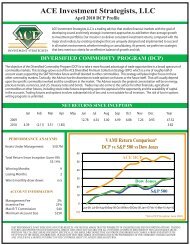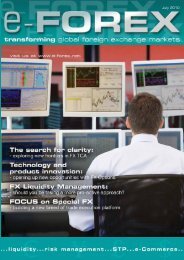You also want an ePaper? Increase the reach of your titles
YUMPU automatically turns print PDFs into web optimized ePapers that Google loves.
RETAIL e-FX PROVIDER<br />
recovery processes for applications, you are putting<br />
your business at additional risk. Automated<br />
application recovery will be more reliable and perform<br />
more predictably because it will not be as dependent<br />
upon the skill of the administrators that are actually<br />
performing the recovery (your best trained<br />
administrators may not always be available when a<br />
real disaster hits).<br />
Step 3: Match the right solutions to your recovery<br />
requirements<br />
Once you’ve determined the key recovery metrics of<br />
RPO and RTO, you’ll need to consider just what type<br />
of IT infrastructure you need to meet them.<br />
Understand the recovery capabilities that various<br />
technologies deliver. Tape has low storage costs, but<br />
supports very lax RPO and RTO and requires a lot of<br />
administrative overhead during recoveries. This,<br />
however, may meet your requirements. If you need<br />
better RPO and RTO performance, you may want to<br />
consider disk. Disk has higher storage costs, but can<br />
support very stringent RPO/RTO, requires<br />
significantly less administrative overhead for<br />
recoveries, and supports access to a variety of next<br />
generation data protection technologies like<br />
continuous data protection (CDP), asynchronous<br />
replication and WAN optimization that solve a lot of<br />
other recovery problems that tape cannot. Finally,<br />
don’t just consider data recovery technologies; look for<br />
technologies that can help automate application<br />
recovery as well for your highest recovery tier<br />
application environments.<br />
114 | january 2010 e-FOREX<br />
Step 4: Test your DR plans<br />
There is a big difference between theory and reality.<br />
We’ve probably all heard the story about the bumblebee.<br />
Scientists evaluating the aerodynamics of the bumblebee,<br />
given what we know about aeronautics, would have to<br />
conclude that it could not fly. And yet it does.<br />
To be sure your DR plan will work as expected, you<br />
have to regularly test it. If you are using some form<br />
of replication to meet stringent DR requirements,<br />
these are <strong>com</strong>plex configurations that can evolve and<br />
degrade over time in unexpected ways. You want no<br />
surprises - your DR plan should work predictably.<br />
Newer technologies like server virtualization and<br />
application failover/failback can help make DR testing<br />
non-disruptive to production environments and much<br />
less expensive than it has been in the past. Regular<br />
testing also helps you fine tune and improve your<br />
recovery capabilities, evolving them over time as your<br />
own recovery requirements evolve.<br />
Illustration of a DR Plan<br />
Headquartered in Salt Lake City, Utah, IBFX is a<br />
leading provider of online foreign exchange trading<br />
services that serves over 35,000 clients across more<br />
than 140 countries. IBFX maintains two data<br />
centers, a main production center in Salt Lake City<br />
that houses all of their business-critical trade servers,<br />
and a remote data center in New York.<br />
With data growth rates skyrocketing, IBFX was<br />
looking to maintain <strong>com</strong>pliance while at the same










